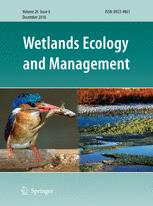Ver ítem
- xmlui.general.dspace_homeCentros Regionales y EEAsCentro Regional Patagonia NorteEEA BarilocheArtículos científicosxmlui.ArtifactBrowser.ItemViewer.trail
- Inicio
- Centros Regionales y EEAs
- Centro Regional Patagonia Norte
- EEA Bariloche
- Artículos científicos
- Ver ítem
Grazing intensity levels influence C reservoirs of wet and mesic meadows along a precipitation gradient in Northern Patagonia
Resumen
Wet meadows are important ecosystems for forage production and as carbon reservoirs in semi-arid areas. In Patagonia, Argentina, large areas of wet meadows have been classified as overgrazed by livestock. The objective of this study was to determine whether long-term overgrazing has affected carbon (C) storage in plant and soil pools in wet and mesic meadows. The study occurred in Northern Patagonia, in three study sites located along a precipitation
[ver mas...]
Wet meadows are important ecosystems for forage production and as carbon reservoirs in semi-arid areas. In Patagonia, Argentina, large areas of wet meadows have been classified as overgrazed by livestock. The objective of this study was to determine whether long-term overgrazing has affected carbon (C) storage in plant and soil pools in wet and mesic meadows. The study occurred in Northern Patagonia, in three study sites located along a precipitation gradient. Our results indicate that long-term overgrazing reduced, on average, 35 % of the total ecosystem C pool. There was significantly lower aboveground and belowground plant production in heavily grazed compared to lightly grazed sites, 419 ± 262 – 128 ± 110 g m2 year−1 and 3796 ± 2622 – 1702 ± 1012 g m2 year−1, respectively. Soil C concentrations were also less in heavily grazed sites (184 ± 98 – 105 ± 58 g kg−1 at 1 m depth, respectively). The response of meadows to long-term heavy grazing also appears to be influenced by different levels of precipitation, with sites in drier areas being apparently more susceptible to overgrazing. Our results indicate that new management and restoration practices are needed to stop and reverse meadow deterioration in degraded meadows of Northern Patagonia.
[Cerrar]

Autor
Enriquez, Andrea Soledad;
Chimner, Rodney Allen;
Cremona, Maria Victoria;
Diehl, Paula;
Bonvissuto, Griselda;
Fuente
Wetlands Ecology and Management 23 (3) : 439–451 (June 2015)
Fecha
2015-06
Editorial
Springer
ISSN
0923-4861
1572-9834
1572-9834
Formato
pdf
Tipo de documento
artículo
Palabras Claves
Derechos de acceso
Restringido
 Excepto donde se diga explicitamente, este item se publica bajo la siguiente descripción: Creative Commons Attribution-NonCommercial-ShareAlike 2.5 Unported (CC BY-NC-SA 2.5)
Excepto donde se diga explicitamente, este item se publica bajo la siguiente descripción: Creative Commons Attribution-NonCommercial-ShareAlike 2.5 Unported (CC BY-NC-SA 2.5)

